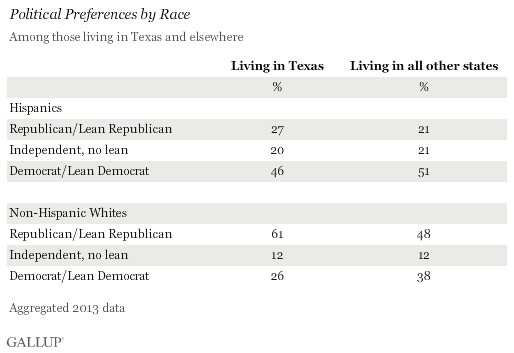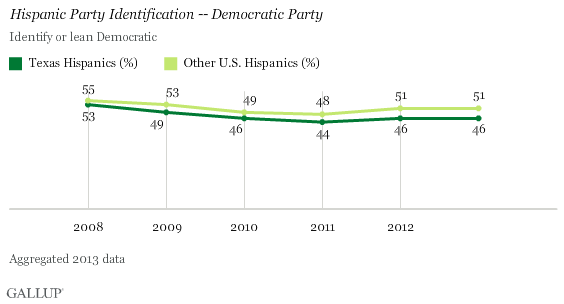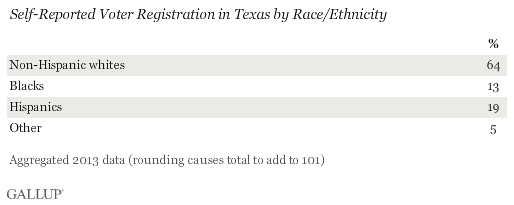WASHINGTON, D.C. -- Texas Hispanics are decidedly Democratic in their political party preferences, 46% to 27%, but that 19-percentage-point Democratic advantage is much smaller in Texas than the average 30-point gap Democrats enjoy among the Hispanic population in the other 49 states. And white Texas residents are decidedly more Republican (61%) than the average among whites residing in other states (48%), complicating whether Texas will turn into a "blue" Democratic state in future elections.

With an increasingly large minority population, including the second-largest Hispanic population of any state, Texas has the potential to see a once-in-a-generation political re-alignment, which could transform the nation's largest reliably Republican state.
These latest results come from 2013 Gallup Daily tracking poll data, which consists of 16,028 Hispanics nationwide, including 2,536 Hispanics residing in Texas. The Lone Star state is experiencing significant changes in its population -- it is one of the top destinations for state to state migration -- and these data provide a crucial, updated look into Texan Hispanics' political preferences over the past year.
Texas holds a gubernatorial race this year, and some Democratic operatives are hoping Texas' evolving demographic makeup will allow them to more effectively compete for the governor's mansion. In 2010, Gov. Rick Perry was re-elected handily, defeating his Democratic opponent by 13 percentage points.
In Texas, GOP Making Small but Meaningful Gains With Hispanics
Relative to 2008 -- the year of President Barack Obama's landslide presidential victory -- Texan Hispanics have gradually become more Republican, even as the percentage of Hispanics identifying with or leaning toward the Republican Party has remained relatively stable nationwide. The six-percentage-point gap between the percentage of Texan Hispanics and Hispanics living in all other states who identify or lean GOP is the highest it has been in over six years.

Meanwhile, Hispanics living in Texas have followed the broad national trend in terms of primarily identifying as Democrats. The 46% of Texan Hispanics who now lean or identify Democratic is seven points below the 2008 crest; by contrast, U.S. Hispanics living in the other 49 states report support of the Democratic Party that has declined by a slightly smaller four points between 2008 and 2013.

Voter Participation and Texan Hispanics
Voter registration among Hispanics lags behind other major racial and ethnic groups in Texas, as it does across the rest of the nation. The average Hispanic adult in Texas is more likely to say they are not registered to vote than are registered, with 43% saying they are registered. No other major race or ethnic group in Texas is so poorly represented in the state's voter registration -- 82% of whites and 77% of blacks say they are registered. Additionally, 50% of non-Texan Hispanics are registered to vote, marking another indication of the challenges faced by those who hope to take political advantage of Texas' large Hispanic population.

This translates into an eligible electorate that remains predominantly white. Among self-reported registered voters in Texas, 64% are non-Hispanic white, 13% are black, and less than a fifth (19%) are Hispanic, further evidence of Hispanics being poorly represented on the state's voter files.
White Texans Continue to Flock to the Republican Party
While Texas has a sizeable proportion of Hispanics living in its borders, nearly half of the population (46%) is non-Hispanic white. This group has grown more heavily Republican over the past five years, a fact that no doubt contributed to President Obama's large 2012 defeat in Texas, larger even than his 2008 drubbing. Currently, 61% of white Texans identify or lean Republican, up four points from 2008. White Texans are also far more likely to identify or lean Republican than are whites living in other states, 48% of which tilt Republican. During this same time period, the overall U.S. white population increased from 44% self-identifying or leaning Republican in 2008 to 48% in 2013.

Implications
Long-suffering Texas Democrats appear to have some hope that their political fortunes in the Lone Star state could soon reverse. The growing Hispanic population, along with the solidly Democratic African-American population, present the best path for the party to move Texas out of its consistent "red state" category and into a more competitive position. Texan Hispanics are more likely to identify as Democrat than Republican, and this could prove advantageous to Democrats.
At the same time, the path toward victory for Democrats may not be as smooth or linear as this logic might suggest. Hispanics in Texas are more likely to identify as Republican than are Hispanics elsewhere, and the Republican Party in Texas has seen more growth in Hispanic support over the past five years than the Democratic Party. While this has not changed the overall equation -- Democrats still lead big among Texan Hispanics -- it does suggest the GOP may be more competitive with this bloc than many assume.
Nor is it clear that Hispanics alone can alter the political trajectory of Texas. While nearly 38% of the Texas population is Hispanic -- over double the national rate -- political participation among this group is not high. So while Texas is a majority minority state in terms of population, differences in political participation by racial and ethnic group -- despite those groups' political leanings -- continue to make Texas a solidly Republican state.
It follows that the biggest challenge for Democrats hoping to turn Texas blue may be in registering and turning out minority voters in that state. But the Democratic Party's relatively poor standing with white Texans will continue to impede its ability to compete on a statewide basis for the foreseeable future.
Survey Methods
Results for this Gallup poll are based on telephone interviews conducted Jan. 1-Dec. 31, 2013, on the Gallup Daily tracking survey, with a random sample of 178,527 adults, aged 18 and older, living in all 50 U.S. states and the District of Columbia.
For results based on the total sample of national adults, one can say with 95% confidence that the margin of sampling error is ±1 percentage points.
Interviews are conducted with respondents on landline telephones and cellular phones, with interviews conducted in Spanish for respondents who are primarily Spanish-speaking. Each sample of national adults includes a minimum quota of 50% cellphone respondents and 50% landline respondents, with additional minimum quotas by time zone within region. Landline and cellular telephone numbers are selected using random-digit-dial methods. Landline respondents are chosen at random within each household on the basis of which member had the most recent birthday.
Samples are weighted to correct for unequal selection probability, nonresponse, and double coverage of landline and cell users in the two sampling frames. They are also weighted to match the national demographics of gender, age, race, Hispanic ethnicity, education, region, population density, and phone status (cellphone only/landline only/both, cellphone mostly, and having an unlisted landline number). Demographic weighting targets are based on the most recent Current Population Survey figures for the aged 18 and older U.S. population. Phone status targets are based on the most recent National Health Interview Survey. Population density targets are based on the most recent U.S. census. All reported margins of sampling error include the computed design effects for weighting.
In addition to sampling error, question wording and practical difficulties in conducting surveys can introduce error or bias into the findings of public opinion polls.
For more details on Gallup's polling methodology, visit www.gallup.com.
